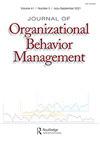Reporting Demographic Variables in JOBM and JAP: A Comparison and Call to Action
IF 1.2
3区 管理学
Q3 MANAGEMENT
Journal of Organizational Behavior Management
Pub Date : 2022-05-29
DOI:10.1080/01608061.2022.2082624
引用次数: 4
Abstract
ABSTRACT Data on participant demographics (e.g., gender, race/ethnicity, socioeconomic status) can be used to evaluate the existence of disparities and other correlations between the impact of an intervention and people’s intersecting identities (e.g., race, ethnicity, gender) yet these data are seldom reported in behavior-analytic studies. To date, no review has been conducted evaluating the reporting of demographic variables within the subfield of organizational behavior management (OBM). OBM interventions often involve multiple participants across levels of an organization, posing unique considerations for reporting demographic variables and potentially identifiable information in accordance with an organization’s preference for disclosure and human resource policies. Interventions in industrial/organizational psychology may encounter similar barriers to reporting demographic variables. Therefore, we reviewed articles published in the Journal of Organizational Behavior Management (JOBM) and the Journal of Applied Psychology (JAP) from 2015 to 2021 to evaluate current trends in the reporting of demographic variables. Studies that included participants and presented data (i.e., both applied and laboratory research; N = 205) were included for review and were coded based on the setting, method, and reported demographic variables. Results indicated that age and gender/sex were reported in about half of studies in JOBM and most studies in JAP, but race, socioeconomic status, and first language were rarely reported across journals. Considerations for reporting demographic variables in OBM and the utility of those data are discussed.JOBM和JAP的人口统计变量报告:比较和行动呼吁
摘要参与者人口统计数据(如性别、种族/民族、社会经济地位)可用于评估干预影响与人们交叉身份(如种族、民族、性别)之间是否存在差异和其他相关性,但这些数据很少在行为分析研究中报告。到目前为止,还没有对组织行为管理(OBM)子领域内的人口统计变量的报告进行评估。OBM干预措施通常涉及跨组织级别的多个参与者,根据组织对披露和人力资源政策的偏好,在报告人口统计变量和潜在可识别信息时提出了独特的考虑因素。工业/组织心理学的干预措施在报告人口统计变量时可能会遇到类似的障碍。因此,我们回顾了2015年至2021年发表在《组织行为管理杂志》(JOBM)和《应用心理学杂志》(JAP)上的文章,以评估人口统计学变量报告的当前趋势。包括参与者和提供数据的研究(即应用研究和实验室研究;N=205)被纳入审查,并根据设置、方法和报告的人口统计变量进行编码。结果表明,JOBM约有一半的研究和日本的大多数研究报告了年龄和性别/性别,但种族、社会经济地位和第一语言很少在期刊上报道。讨论了在OBM中报告人口统计变量的注意事项以及这些数据的效用。
本文章由计算机程序翻译,如有差异,请以英文原文为准。
求助全文
约1分钟内获得全文
求助全文
来源期刊
CiteScore
2.70
自引率
47.60%
发文量
26
期刊介绍:
The Journal of Organizational Behavior Management—the official journal of the OBM Network (www.obmnetwork.com)—is a periodical devoted specifically to scientific principles to improve organizational performance through behavioral change. The journal publishes research and review articles, reports from the field, discussions, and book reviews on the topics that are critical to today"s organization development practitioners, operations managers, and human resource professionals.

 求助内容:
求助内容: 应助结果提醒方式:
应助结果提醒方式:


